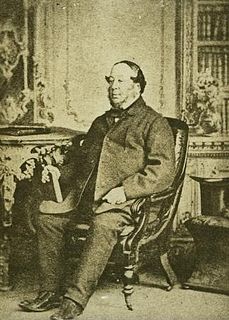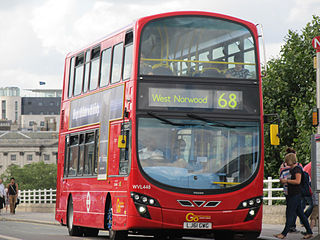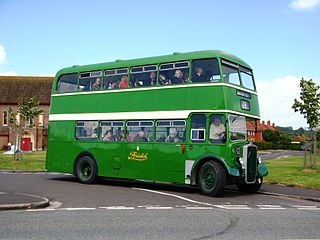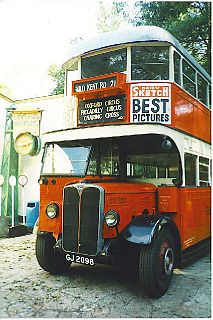
The Star Omnibus Company and its predecessor the Andrews Star Omnibus Company, was a bus operator in London between 1892 and 1908.

The Star Omnibus Company and its predecessor the Andrews Star Omnibus Company, was a bus operator in London between 1892 and 1908.
Solomon Andrews entered into agreement with the London General Omnibus Company in 1886 to supply Andrews patent buses. [1] The Andrews patent bus represented an improvement in design over the vehicles previously used. [2] They were so successful that by 1891, 26 buses had been supplied.
On 4 October 1892, a limited company was formed, Andrews Star Omnibus Company Limited, to take over the business of some buses which had been operating since 1888 under the name of S. Andrews & Son. The Directors were Solomon Andrews and his son, Francis Emile. The General Manager was William Alexander Perry. The company was based at 31-47 New Kent Road, leased from Samuel Plimsoll.
In 1892 the routes of the company were as follows:
Later routes were added as follows:

On 4 March 1899 the Star Omnibus Company (London) Limited was formed to take over the business of the Andrews Star Omnibus Company. The directors were the same and William Alexander Perry was the Managing Director.
By 1900 the company had 196 buses, and 1,797 horses. The company continued to expand and by 1902 there were 246 buses and 1,905 horses. In this year, there were negotiations with the London General Omnibus Company for it to take over the company for £222,750 (equivalent to £23,753,524 in 2018), [3] but the deal was unsuccessful. The company started to experience financial difficulties, reportedly because of the increase in electric tramway services in London.
In 1905 the company purchased some motor buses, but these were unreliable and failed to deliver any profit for the company. The situation deteriorated, and the company withdrew the motor buses on 9 August 1907.
In line with most other bus operators in London, there was a significant drop in profit, and the Star Omnibus Company was unable to withstand the competition from the London Underground and the tramway services. The company was wound up on 21 February 1908.
When the company ceased trading, the brother of William Alexander Perry, A.J. Perry purchased some vehicles and three of these survived.
This bus was owned by Bernard Mills Circus. It was then operated on a service between Chessington South railway station and Chessington Zoo from 1944 to 1948. It was obtained by a descendant of Solomon Andrews, John Andrews in 1963. It was renovated and took part in the George Shillibeer 150th anniversary in 1979. It was given to the London Bus Museum in 2007.
This bus was owned by Bernard Mills Circus. It was then operated on a service between Chessington South railway station and Chessington Zoo from 1944 to 1948. It was sold to Car Mart, then George Mathey, and put on display at the Tyrwhitt-Drake Museum of Carriages at Maidstone. In 1967 it was purchased by Temple Smith of Chicago. Back from the United States of America in 1989, it was restored. It was given to the London Bus Museum in 2007.
The bus passed into the ownership of Job Master Robert Barley, then Dollond & Aitchison. Bernard Mills bought it in 1948 and then it went to Tim Richards of Gawsworth Hall. It was renovated and took part in the George Shillibeer 150th anniversary in 1979 and operated a service to London Zoo. The Andrews family took it back to Cardiff in 1988 for restoration, and it was given to the London Bus Museum in 2007. It is on loan to the Beamish Museum.

George Shillibeer was an English coachbuilder.

Midland Red was a bus company that operated in The Midlands from 1905 until 1981. It was one of the largest English bus companies, operating over a large area between Gloucester in the south and Derbyshire in the north, and from Northampton to the Welsh border. The company also manufactured buses.

First Eastern Counties, trading as First Norfolk & Suffolk, is a bus operator providing services in Norfolk and Suffolk in eastern England. It is a subsidiary of FirstGroup.

The Nottinghamshire and Derbyshire Tramways Company was formed in 1903 to build a tramway linking Nottingham, Derby, and Ilkeston, in Derbyshire, England. But only a short section was built.
Birmingham City Transport was the local authority-owned undertaking that provided road-based public transport in Birmingham, England, between 1899 and 1969. It was locally known as the Corporation Buses. Initially, it was called Birmingham Corporation Tramways, and, after the first motor bus services started in July 1914, it became Birmingham Corporation Tramways and Omnibus in 1928. Finally, in November 1937, it was renamed "Birmingham City Transport", though Birmingham itself had been a City since 1889. It was incorporated into the West Midlands Passenger Transport Executive in 1969.
Solomon Andrews was a British entrepreneur and head of the Solomon Andrews and Son bus and tram-operating company, based in Cardiff.
The Hawthorn Tramways Trust was a tram operator in Melbourne, Australia. Its assets and liabilities were transferred to the Melbourne & Metropolitan Tramways Board on 2 February 1920.

London Buses route 68 is a Transport for London contracted bus route in London, England. Running between West Norwood station and Euston bus station, it is operated by Abellio London.

The Bristol Omnibus Company was the dominant bus operator in Bristol, and was one of the oldest bus companies in the United Kingdom. It ran buses over a wide area of Gloucestershire, Somerset, Wiltshire and neighbouring counties.

First West of England is a bus operator providing services in Bristol, Bath, Somerset, South Gloucestershire and West Wiltshire. It is a subsidiary of FirstGroup.

Thomas Tilling Ltd, later known with its subsidiary companies as the Tilling Group, was one of two conglomerates that controlled almost all of the major bus operators in the United Kingdom between World Wars I and II and until nationalisation in 1948.

Buses play a major role in the public transport of the United Kingdom, as well as seeing extensive private use. While rail transport has increased over the past twenty years due to road congestion, the same does not apply to buses, which have generally been used less, apart from in London where their use has increased significantly. Bus transport is heavily subsidised, with subsidy accounting for around 45 per cent of operator revenue, especially in London. In 2014/15, there were 5.2 billion bus journeys in the UK, 2.4 billion of which were in London.

Devon General was the principal bus operator in south Devon from 1919. The name was first used by the Devon General Omnibus and Touring Company which was created in 1919. In 1922 it was purchased by the National Electric Construction Company which merged with British Electric Traction in 1931. Nationalisation in 1969 resulted in 1971 with the company being merged into Western National. In 1983 a new Devon General Limited was created which became the first operating subsidiary of the National Bus Company to be privatised in 1986 when it became the first company of Transit Holdings. It was sold to the Stagecoach Group in 1996 and renamed Stagecoach Devon in 2003.

A horse-bus or horse-drawn omnibus was a large, enclosed and sprung horse-drawn vehicle used for passenger transport before the introduction of motor vehicles. It was mainly used in the late 19th century in both the United States and Europe, and was one of the most common means of transportation in cities. In a typical arrangement, two wooden benches along the sides of the passenger cabin held several sitting passengers facing each other. The driver sat on a separate, front-facing bench, typically in an elevated position outside the passengers' enclosed cabin. In the main age of horse buses, many of them were double-decker buses. On the upper deck, which was uncovered, the longitudinal benches were arranged back to back.

Cardiff Tramways Company operated a horse tramway service in Cardiff between 1872 and 1902.
The Worcester Electric Traction Company operated a tramway service in Worcester between 1904 and 1928.
Perth Corporation Tramways operated an electric tramway service in Perth, Scotland between 1903 and 1929.
The Pontypridd and Rhondda Valley Tramway operated a tramway service in Pontypridd and Porth between 1888 and 1902.
The Provincial Tramways Company was a holding company for horse tramway companies in various regional towns of England. It was floated in July 1872 by means of a prospectus inviting public subscription for shares in the new company. The published prospectus lists the towns where it was proposed to operate horse tramways as Plymouth. Cardiff, Dundee. Portsmouth. Southampton and Tynemouth. Initially those in Plymouth and Cardiff were constructed and in operation as reported to the half yearly meeting of the company in 1873.
The Portsmouth Street Tramways Company operated horse tramways in Portsmouth, England. It was started under the terms of a Provisional Order of 1874 and was a wholly owned subsidiary company of The Provincial Tramways Company.